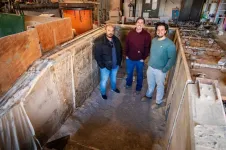(Press-News.org)
MIAMI, FLORIDA (EMBARGOED UNTIL JAN. 9, 2024 AT 4 PM EST) – A multicenter collaboration led by researchers at Sylvester Comprehensive Cancer Center at the University of Miami Miller School of Medicine has produced the first computational model for newly diagnosed multiple myeloma that predicts an individual’s personalized prognosis based on their tumor genomics and treatments.
The prediction model for individualized risk in newly diagnosed multiple myeloma, or IRMMa, improves on previous prognostic tools because it takes into account the biology of patients’ tumors, said Dr. C. Ola Landgren, chief of the Division of Myeloma and director of the Sylvester Myeloma Institute, senior author of an article unveiling the new tool in the Journal of Clinical Oncology. This is important in many cancers, but especially in multiple myeloma, which is highly variable. In fact, the researchers identified 12 distinct subtypes of the disease, a classification that had not been made before.
“The future of the field will have to be focused on precision medicine,” Landgren said. “There’s no other way forward.”
The original method for classifying multiple myeloma, developed in the 1970s, was based on staging for solid tumors. It relied on the amount of cancer present, and with the treatments available at the time, it was fairly accurate, Landgren said. But with newly developed therapies, especially immunotherapies, the amount of cancer is often less important than the nature of the cancerous cells. Different kinds of driver mutations in the tumor genome affect the cancer’s growth, so certain subtypes of myeloma could have a very good outcome even if they’re diagnosed when the cancer is widespread, assuming the right treatment is matched to the patient.
The number of treatment options for the disease has dramatically expanded in the past two decades, and patients are living longer with the disease. But with so many therapeutic choices, physicians need a way to predict which treatment will work best for each patient.
Dr. Francesco Maura, an assistant professor at Sylvester and first author on the study, said that although prognostic tools have been updated through the years, the field has still lacked precise prediction. Some tools included tumor genomic features, but there have been recent new findings about genomic risk factors that had not yet been included in a prediction model. And all the tools to date relied on averages of a population, lumping patients into groups like “standard risk” and “high risk” and giving prognoses for those groups overall that didn’t take into account individualized risk and how this can be modified by distinct treatments.
“Our model is based on the idea of predicting the risk of the individual patient rather than that of the group,” Maura said.
Because it’s built using deep learning, IRMMa can learn and improve as it receives more data. The model is built in a manner that allows emerging datasets with future treatment strategies to be added. The research team is now working on including additional datasets from patients treated with newer antibody-based multiple myeloma therapies.
To build the model, the Sylvester researchers and their collaborators used genetic, treatment and clinical data from nearly 2,000 patients newly diagnosed with multiple myeloma. From sequences of the patients’ DNA, the scientists first identified 90 “driver genes” — genes bearing mutations in the cancer cells that appear to spur tumor growth. They then looked at the treatments each patient in their dataset received and how the patients fared on those treatments, matching treatment outcome to an individual’s tumor genetic sequences.
The Sylvester team worked with scientists at Memorial Sloan Kettering Cancer Center, NYU Langone Health, Moffitt Cancer Center and Heidelberg University Hospital to amass the patient data. The model is available online for anyone to use, although its current iteration is aimed at researchers rather than clinicians, Maura said. It could be useful for researchers interpreting or designing new clinical trials, for example, to provide a large set of comparisons to the experimental treatment.
Maura and his colleagues also aim to improve the model by integrating more patient data.
“This model can only grow with the help of the research community,” Maura said. “The next challenge is to keep feeding it with the right datasets so at a certain point it will be usable for clinical purposes.”
IRMMa is also flexible. A patient’s prognosis from the model can be changed if, for example, they receive a transplant after a given treatment. When new therapies become available, as long as there is data from at least a few hundred patients, the model can be updated to incorporate those treatments.
While the field isn’t quite at the point of sequencing entire tumor genomes for every newly diagnosed patient, that might come in the near future as whole genome sequencing becomes more economical, Landgren said.
“More and more information will become available, and tools like this model are the future for optimized treatment and management,” he said.
# # #
END
“Identifying plasma proteins that regenerate aged or damaged ovaries could lead to more effective, targeted and/or preventive therapies for patients.”
BUFFALO, NY- January 9, 2024 – A new research paper was published in Aging (listed by MEDLINE/PubMed as "Aging (Albany NY)" and "Aging-US" by Web of Science) Volume 15, Issue 24, entitled, “Systemic changes induced by autologous stem cell ovarian transplant in plasma proteome of women with impaired ovarian reserves.”
Patients with poor ...
People who own electric vehicles (EVs) are more likely to go a step further and add solar panels to their home, according to an analysis of a behavioral study by researchers at the U.S. Department of Energy’s National Renewable Energy Laboratory (NREL). Conversely, the impact of owning solar panels also has a bearing on whether a homeowner buys an electric vehicle but not as strongly.
The study relied on a survey of 869 households in the San Francisco Bay Area.
NREL’s Shivam Sharda, lead author of the newly published research paper that analyzes the ...
University of Colorado Cancer Center member Sana Karam, MD, PhD, has received a translational research grant from the V Foundation for Cancer Research, co-founded by ESPN and legendary basketball coach Jim Valvano, to study a new therapeutic that may help pancreatic cancer patients overcome resistance to radiation therapy.
“Pancreatic cancer is deadly. The only treatment that can cure it is surgery to fully remove the tumor, but that is only an option when the cancer is caught early, which is rare,” Karam explains. “Radiation alone to shrink tumors before surgery has been tried, but with limited benefit. By studying patient ...
New research overseen by University of Colorado Cancer Center member Rebecca Schweppe, PhD, could lead to improved treatment for people with thyroid cancer characterized by a mutation in the BRAF gene — a mutation also responsible for some types of melanoma, colorectal cancer, leukemia, lymphoma, and ovarian cancer.
“The BRAF mutation is a common mutation in thyroid cancer,” Schweppe says. “It has a high prevalence of mutations in two different subtypes — papillary thyroid cancer, or PTC, and anaplastic thyroid cancer, or ATC — and there's a lot of interest in targeting this pathway. Other tumor types, like melanoma ...
Waltham — January 8, 2024 — Proper procedures for diagnosing prolonged grief disorder (PGD) are not being followed in research into its prevalence, according to a study published in Harvard Review of Psychiatry, part of the Lippincott portfolio from Wolters Kluwer. What’s more, most published literature doesn’t clearly acknowledge the limitations of the methodology used.
The lead investigator was Margaret S. Stroebe, PhD, a clinical psychologist at Utrecht University and the University of Groningen ...
The University of Rochester will house a new national center focused on using tissue-on-chip technology to develop drugs more rapidly and reduce the need for animal trials. The National Institutes of Health awarded a $7.5 million grant to establish the Translational Center for Barrier Microphysiological Systems (TraCe-bMPS) at Rochester in partnership with Duke University.
The center aims to develop five Food and Drug Administration–qualified drug development tools related to ...
Police reform movements often focus on improving police-public relationships. These ties are a focus of community policing and procedural justice, two significant reform efforts in policing worldwide over the last three decades. In a new article, researchers examine issues involved in these efforts, especially limitations to communication, and highlight implications for police-community relations.
The article, by researchers at Arizona State University (ASU) and the University of California, Santa Barbara (UCSB), is published in Psychology, Public Policy, and the Law.
“Reform movements that try to improve relationships ...
Managing public order at large demonstrations, protests, and assemblies is a demanding and necessary task. A new book provides an international review of public order management experiences and effective practices. Through practical examples grounded in multidisciplinary theory and science, the book offers a roadmap to improve police response and increase safety at large gatherings in democratic countries.
The book, Public Order Policing: A Professional's Guide to International Theories, Case Studies, and Best Practices, was edited by researchers at the University of Nevada, Las Vegas (UNLV); ...
Washington, D.C. – The U.S. Department of Energy (DOE) today announced awards totaling $24 million for small businesses in 30 states and the District of Columbia. The 111 projects funded by DOE’s Office of Science include the development of computing, advanced materials, and scientific instrumentation that will help advance the department’s clean energy mission.
“Small businesses are the cornerstone of America and contribute significantly to the growth of our economy,” said Asmeret Asefaw Berhe, ...
Climate change is leading to an increase in sea level rise, putting millions of people in danger of severe coastal flooding in coming years.
Sherif Abdelaziz, associate professor in the Charles E. Via, Jr. Department of Civil and Environmental Engineering at Virginia Tech, is collaborating with researchers from Heriot-Watt University in Edinburgh, Scotland, to find solutions to keep coastal areas safe by enhancing the resilience of sea walls against increasing coastal flooding. The PIONEER project is funded by the Engineering and Physical Sciences Research Council and is aiming to be the initial step in a global collaboration to strengthen coastal ...





